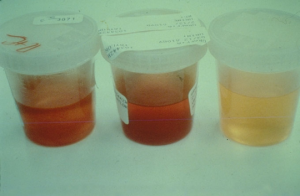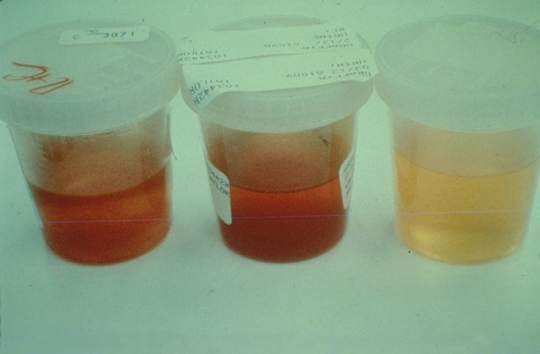The kidney functions as the body’s main excretory organ. It eliminates the body’s metabolic wastes. Urine is formed in the kidneys, stored in the urinary bladder then excreted in the urethra. The normal color of urine ranges from pale yellow to deep amber. A colorless urine may indicate that a person may have been drinking too much water. Urine pigment is due to the urobilin or urochrome—a pigment that is thought to give the urine its color. A normal color of the urine tells a lot about the kidney and liver function of a person.
Most changes of the urine color may be temporary and may be a result of food or drinks we intake, medications or trauma. Changes of urine color may be alarming to many people. This is where assessment and history will be a big help in understanding. Many people will immediately go to a medical institution in order to find out what could have caused the discoloration. Some doctors will order a urinalysis as primary step in order to rule out any presence of a problem.
Taking The History
 A person who seeks medical advice for dark colored urine should participate in taking his or her history of food, drink, or drug intake. Recalling the foods you took for the past twenty four hours or few days can be beneficial. Medication intake history can greatly help the medical practitioner taking your history to rule out any drugs that can cause urine color changes as side effects. If there is a trauma, the part of the body affected by trauma may also be a cause of the discoloration especially when there is trauma on the abdomen or on the pelvic area, this may be the cause of the dark colored urine. Red colored urine may indicate internal bleeding or trauma to the tissues on or near the urinary tract or kidneys. Trauma on the lower back portion of the torso may cause blood in the urine. A cloudy or murky colored urine may indicate that there is a presence of an infection and often times, the medical doctor may order a urinalysis to know the number of bacteria causing the infection. This can be treated with antibiotics. After a number of days of antibiotic therapy, the urine is again tested for decreased bacterial count and a sign that the infection has improved or is no longer present is that the color of urine goes back to the normal color of light yellow to amber.
A person who seeks medical advice for dark colored urine should participate in taking his or her history of food, drink, or drug intake. Recalling the foods you took for the past twenty four hours or few days can be beneficial. Medication intake history can greatly help the medical practitioner taking your history to rule out any drugs that can cause urine color changes as side effects. If there is a trauma, the part of the body affected by trauma may also be a cause of the discoloration especially when there is trauma on the abdomen or on the pelvic area, this may be the cause of the dark colored urine. Red colored urine may indicate internal bleeding or trauma to the tissues on or near the urinary tract or kidneys. Trauma on the lower back portion of the torso may cause blood in the urine. A cloudy or murky colored urine may indicate that there is a presence of an infection and often times, the medical doctor may order a urinalysis to know the number of bacteria causing the infection. This can be treated with antibiotics. After a number of days of antibiotic therapy, the urine is again tested for decreased bacterial count and a sign that the infection has improved or is no longer present is that the color of urine goes back to the normal color of light yellow to amber.
Food Coloring Additives
Some food additives are used to enhance food consumption. Food colors entice us and gives food an interesting color. Several pigments from food such as the Betacyanin can make urine reddish or brown in color. Tomatoes, tomato sauce, beetroot, blueberries, red licorice, red colored drinks, and red food coloring gives the urine a reddish to brown color also.
Drugs Causing Dark Colored Urine
 The anti-tuberculosis drugs, Rifampicin and Isoniazid, may cause the urine to turn reddish or dark orange. This is a side-effect that needs not to be alarmed. Some people taking Rifampicin may stop the drug because they are alarmed with the color changes in urine. It is an important thing that should be discussed by the doctor who prescribed the medication to avoid patients to stop the drug. The anti-parasitic and antibiotic drug, Metronidazole, is also famous for causing a red tinged to rusty colored urine. Just like any anti-biotic drug therapy, compliance is important in order to have an effectively kill bacteria causing disease. This should not be stopped and should not be suspected of causing bleeding in the urine. Nitrofurantoin is a strong antibiotic to treat urinary tract infection. This urine discoloration should not be suspected as a worsening of the urinary tract infection. Knowledge of the drug side effects can help a consumer a lot. It also helps decrease anxiety in a drug therapy.
The anti-tuberculosis drugs, Rifampicin and Isoniazid, may cause the urine to turn reddish or dark orange. This is a side-effect that needs not to be alarmed. Some people taking Rifampicin may stop the drug because they are alarmed with the color changes in urine. It is an important thing that should be discussed by the doctor who prescribed the medication to avoid patients to stop the drug. The anti-parasitic and antibiotic drug, Metronidazole, is also famous for causing a red tinged to rusty colored urine. Just like any anti-biotic drug therapy, compliance is important in order to have an effectively kill bacteria causing disease. This should not be stopped and should not be suspected of causing bleeding in the urine. Nitrofurantoin is a strong antibiotic to treat urinary tract infection. This urine discoloration should not be suspected as a worsening of the urinary tract infection. Knowledge of the drug side effects can help a consumer a lot. It also helps decrease anxiety in a drug therapy.
Blood in the Urine

Definitely, yes!
Blood in the urine is also known as hematuria. Red blood cells do exist in small amounts in our urine. This is normal in a few amounts but can be very alarming when it reaches beyond the normal range. This can be caused by glomerular damage, stones in the urinary tract, tumors, kidney trauma, acute tubular necrosis. It is not advisable to take a urinalysis when a woman is menstruating since it can have increased red blood cell count result. Some urinary bladder problems may cause blood in the urine. Examples of this is when there is urinary retention and bladder distention. When the person is unable to expel urine, the bladder distends and pressure causes trauma to the bladder walls and may cause bleeding. A straight catheterization should be done to prevent the bladder from further injury such as a rupture.
The kidney functions as the body’s main excretory organ. It eliminates the body’s metabolic wastes. Urine is formed in the kidneys, stored in the urinary bladder then excreted in the urethra. The normal color of urine ranges from pale yellow to deep amber. A colorless urine may indicate that a person may have been drinking too much water. This pigment is due to the urobilin or urochrome—a pigment that is thought to give the urine its color. A normal color of the urine tells a lot about the kidney and liver function of a person.
Most changes of the urine color may be temporary and may be a result of food or drinks we intake, medications or trauma. Changes of urine color may be alarming to many people. This is where assessment and history will be a big help in understanding. Many people will immediately go to a medical institution in order to find out what could have caused the discoloration. Some doctors will order a urinalysis as primary step in order to rule out any presence of a problem.
Taking The History
A person who seeks medical advice for dark colored urine should participate in taking his or her history of food, drink, or drug intake. Recalling the foods you took for the past twenty four hours or few days can be beneficial. Medication intake history can greatly help the medical practitioner taking your history to rule out any drugs that can cause urine color changes as side effects. If there is a trauma, the part of the body affected by trauma may also be a cause of the discoloration especially when there is trauma on the abdomen or on the pelvic area, this may be the cause of the dark colored urine. Red colored urine may indicate internal bleeding or trauma to the tissues on or near the urinary tract or kidneys. Trauma on the lower back portion of the torso may cause blood in the urine. A cloudy or murky colored urine may indicate that there is a presence of an infection and often times, the medical doctor may order a urinalysis to know the number of bacteria causing the infection. This can be treated with antibiotics. After a number of days of antibiotic therapy, the urine is again tested for decreased bacterial count and a sign that the infection has improved or is no longer present is that the color of urine goes back to the normal color of light yellow to amber.
Food Coloring Additives
Some food additives are used to enhance food consumption. Food colors entice us and gives food an interesting color. Several pigments from food such as the Betacyanin can make urine reddish or brown in color. Tomatoes, tomato sauce, beetroot, blueberries, red licorice, red colored drinks, and red food coloring gives the urine a reddish to brown color also.
Drugs Causing Dark Colored Urine
The anti-tuberculosis drugs, Rifampicin and Isoniazid, may cause the urine to turn reddish or dark orange. This is a side-effect that needs not to be alarmed. Some people taking Rifampicin may stop the drug because they are alarmed with the color changes in urine. It is an important thing that should be discussed by the doctor who prescribed the medication to avoid patients to stop the drug. The anti-parasitic and antibiotic drug, Metronidazole, is also famous for causing a red tinged to rusty colored urine. Just like any anti-biotic drug therapy, compliance is important in order to have an effectively kill bacteria causing disease. This should not be stopped and should not be suspected of causing bleeding in the urine. Nitrofurantoin is a strong antibiotic to treat urinary tract infection. This urine discoloration should not be suspected as a worsening of the urinary tract infection. Knowledge of the drug side effects can help a consumer a lot. It also helps decrease anxiety in a drug therapy.
Blood in the Urine
Blood in the urine is also known as hematuria. Red blood cells do exist in small amounts in our urine. This is normal in a few amounts but can be very alarming when it reaches beyond the normal range. This can be caused by glomerular damage, stones in the urinary tract, tumors, kidney trauma, acute tubular necrosis. It is not advisable to take a urinalysis when a woman is menstruating since it can have increased red blood cell count result. Some urinary bladder problems may cause blood in the urine. Examples of this is when there is urinary retention and bladder distention. When the person is unable to expel urine, the bladder distends and pressure causes trauma to the bladder walls and may cause bleeding. A straight catheterization should be done to prevent the bladder from further injury such as a rupture.
